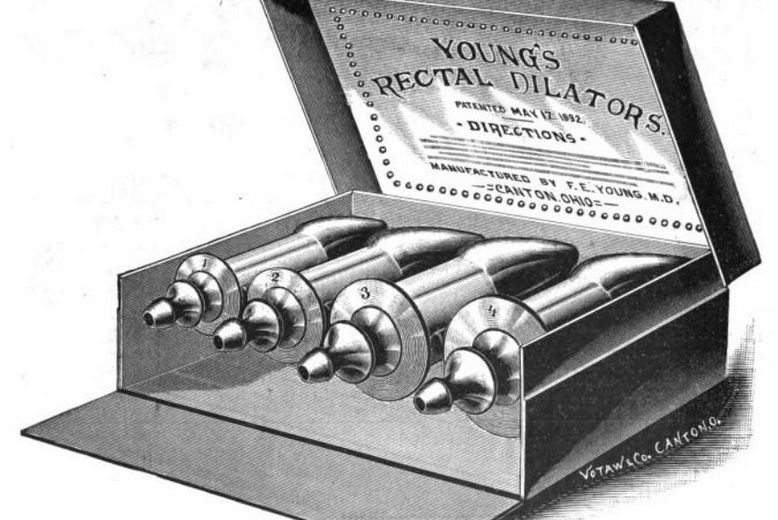Humans have been carving and using many different devices for pleasure since the beginning of time. We not only learned how to use tools to create shelter, clothing, works of art, and weapons as we evolved but used those tools to make sex toys. The dildo is as old as, well, dirt but I was surprised to find that other sex toys weren’t fully fleshed out until the 19th century. One such item is the butt plug.
I was hard pressed to find much evidence of butt plugs before the 1800s. I’m surprised because I can’t imagine the concept of toys for anal play just sprung into someone’s mind a little over a century ago. Anal pleasure seems to have been limited to manual, genital, and dildo penetration. A flanged base was nowhere to be seen as far as I could tell. The only prehistory I could find was the practice of “Figging” which is the practice of peeling ginger into a butt plug shape then inserted vaginally or anally. Figging was a form of punishment or torture. Today it is used in consensual BDSM play.
Just to be clear, a butt plug is a device that has a cone shaped or anatomically correct shaped end that is inserted into the anus. It has a flanged base to keep it from slipping further inside thus rendering it irretrievable by any means not requiring a trip to the emergency room. The area between the flanged base and the central part of the plug curves in sharply to prevent the butt plug from slipping out. A butt plug is different than an anal plug for medical use. A medical anal plug does not have a cone shape but a disc or plug shape to prevent fecal incontinence. A butt plug can be worn for added pleasure during sex, during masturbation or even worn during the course of the day for continual sexual stimulation. Modern butt plugs vary in width, length, and shape. They also come in a rainbow of colors and a variety of materials. But where are the butt plugs of the past?
The earliest example of a butt plug I could find were rectal dilators used to help with constipation and hemorrhoids, also known as piles. The most famous dilators were a set sold as Dr. Young’s Ideal Rectal Dilators from 1893 to 1940. Dr. Frank E. Young of Canton, Ohio patented his rectal dilators in 1892. Advertisement for Dr. Young’s patented rectal dilators can be seen by 1893. The package includes several dilators of increasing sizes in a somewhat familiar butt plug shape of today; olive-shaped tip with a straight shaft and flanged end. They were originally made of rubber, and the instructions suggested they be used with either Dr. Young’s Piloment lubrication or vaseline. One would gradually insert the dilator then as one adjusted to the size, would move up to the bigger size. The dilator relaxed and stretched the rectum to either relieve constipation or to allow hemorrhoids to heal. This treatment is still used today. One surprising recommendation for use back in the late 19th century was to prevent or treat insanity. Thankfully something the dilators are not used for today.
Dr. Young was not the only person to recommend the use of rectal dilators. There were others who came up with their own versions.
George Starr White used a method he called The Finer Forces of Nature to “… diagnose and treat all manner of unhealth.” He started his research on his particular form of medical treatments as early as 1881. One of the devices he sold was the Valens Bio-Dynamo Prostatic and Rectal Normalizer around 1928. White wrote many books about his cures and methods of diagnosis, many of which rely on natural remedies. 1931. His theories about chromotherapy and “The Golden Planet” of his true origin, remind me of an early L. Ron Hubbard. The Federal Trade Commission forced him to discontinue advertising his prostate treatment in 1931.
The Recto Rotor looks longer than most of the rectal dilators I’ve seen but was marketed for the same conditions; piles, constipation, and prostate trouble. Its extended length gave it access to the prostate, and it bills itself as “… the only device that reaches the Vital Spot effectively.” This product may be trying to do too many things at once since it also has vent holes to apply lubrication, or as the ad description says, “… through which the undulant inserted in the chamber below may be forced out by turning the knurled cap.” Everything about the Recto Rotor makes Young’s dilators look tame. The “knurled cap” doesn’t look like it’s flanged in any way so I can’t tell if this is supposed to be left in or just held by the user.
Some products were variations on Dr. Young’s rectal dilators such as Whitehead’s Dilator from the 1870’s and Thebaud’s sphincter-ani dilator from the 1880’s. Curvlite made glass rectal dilators and were around until about 1950’s. These look a bit more like the spawn of a standard butt plug and a chandelier light bulb than the straight-sided bulb tipped Dr. Young version. The bulbous main body of the plug has an extension at the tip that makes it look a bit gentler than Young’s. Just like Young’s dilators, these come in various widths so you can “gradually” increase the girth. I saw a set similar to the Curvilite glass set but made out of bakelite. It was on an online auction site, so there wasn’t much info but they seemed to have many early 20th to mid-century dilators mostly culled from eBay. I even found a company called Klystra (an enema supply company) that had a self-proclaimed takeoff on Young’s dilators complete with replica packaging. Unfortunately, Klystra has gone out of business so you can’t actually order one.
I found only one device that had a unique shape. The box is labeled The Talisman and has an entirely different shape that the ones I previously mentioned. It has a curved shape before ending at the olive-shaped tip. The auction house that was advertising it labeled it as a 19th-century medical vulcanite rectal dilator but the narrow shaft and curved angle looks more like it’s intent is to put pressure on the prostate. It looks more built for pleasure than for medical purposes, but since companies couldn’t advertise their products as pleasurable until relatively recently, we may never know the creators intent. It’s difficult to determine when these dilators turned from medicinal to pleasurable. While I’m sure someone had to look at them and think “oooh, that looks like fun,” no one was going to put that publicly in a catalog or advertisement for quite some time.
There had to be someone to who sold butt plugs for pleasure, but I have yet to find who that is. The first official brick and mortar sex shop, Beate Uhse’s Specialty Store for Marital Hygiene, was opened up in Germany in the 1960’s. Before that, Beate sold her products along with contraception advice through a catalog. I’m hoping to find some surviving examples of early catalogs like Beate Uhse’s to the first distributor. I look forward to having more info for the next Anal August


